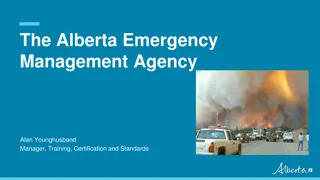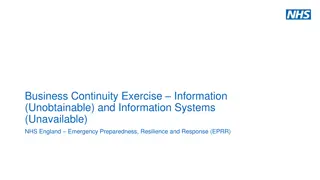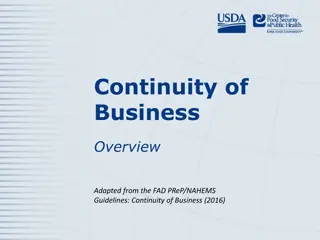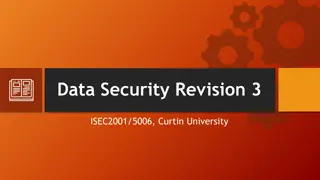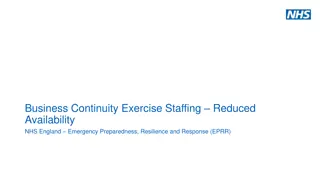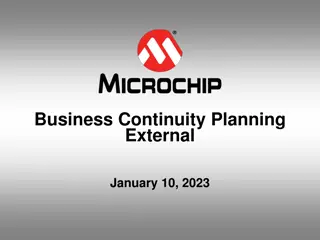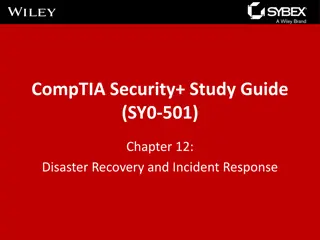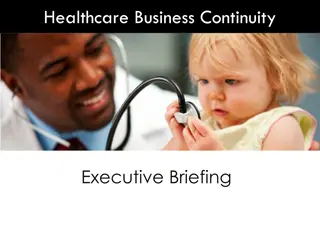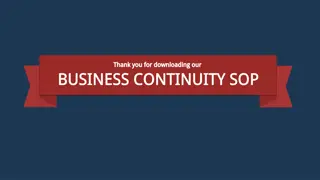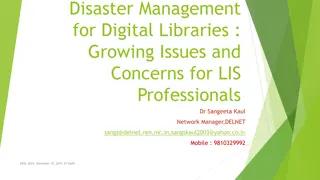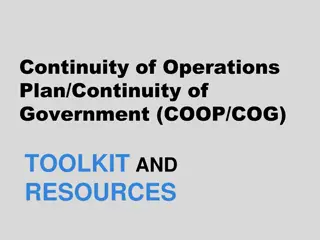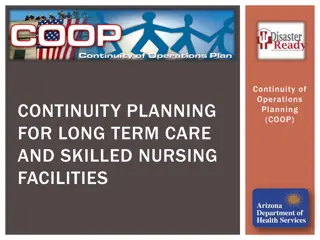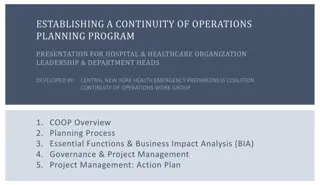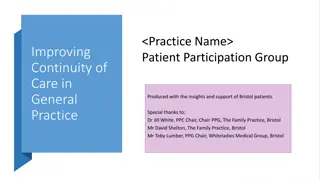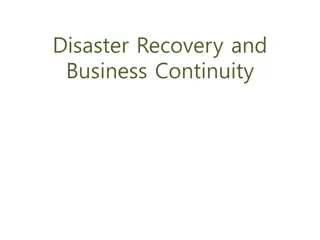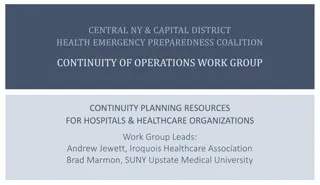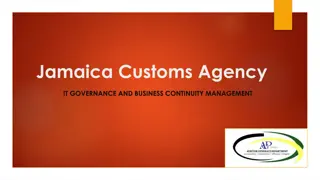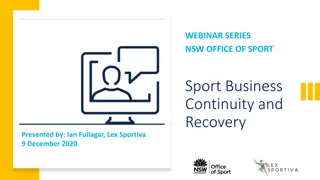Business Continuity Planning: Ensuring Uninterrupted Operations
Business Continuity Planning (BCP) is essential for maintaining critical business functions during and after disasters. It involves designing policies, procedures, and a Disaster Recovery Strategy to secure data and ensure business continuity. BCP includes analyzing, developing, testing, and training for quick restoration of vital processes. Disaster Recovery (DR) complements BCP by focusing on recovering technology infrastructure post-disaster. Automating data backups and leveraging external systems are key aspects of a successful DR plan.
Download Presentation

Please find below an Image/Link to download the presentation.
The content on the website is provided AS IS for your information and personal use only. It may not be sold, licensed, or shared on other websites without obtaining consent from the author.If you encounter any issues during the download, it is possible that the publisher has removed the file from their server.
You are allowed to download the files provided on this website for personal or commercial use, subject to the condition that they are used lawfully. All files are the property of their respective owners.
The content on the website is provided AS IS for your information and personal use only. It may not be sold, licensed, or shared on other websites without obtaining consent from the author.
E N D
Presentation Transcript
Business Continuity Planning
Business Continuity Business Continuity Planning (BCP) involves designing and creating policies and procedures that ensure that essential business functions/processes are available during and after a disaster. Not just about natural disasters, technology failures and security breaches Include a Disaster Recovery Strategy Securing your and your customer s data is critical Create specific to your organizations needs
Planning for Success 01 02 03 HOW TO BUILD YOUR PLAN DISASTER RECOVERY SECURITY
BCDR Planning Analyze Develop Test Train Organize What critical business functions and time sensitive processes need to be restored quickly? Write down the people process and tools/technologies you need in order to perform business as usual. Layout the plan to get each person and system up and running in the event of a disaster. Who do you contact, how do you get access, how long can you work this way? Establish a team who will own the plan. As owners they should evaluate, test and update in an ongoing manner so that the plan is never out of date or behind when organizational changes happen. New and exiting employees should be trained periodically on the plan and the part they should play. Present employees with exercises to test their knowledge of the plan. Conduct unannounced work remote events so to test their readiness to execute the plan. Restore and verify backups work. Execute, test and update the plan annually to ensure it will be successful. This is one of the most important steps that could mean disaster or success so don t skip it. Repeat
BC Planning What you use, who uses them and how to perform key business functions How long can any of your systems handle being down? Do you have technology partners who plan for the unexpected as you are doing? Do your people periodically test their access ad ability to work if a sudden remote situation is presented? Can you restore your data quickly and as planned? Have you tested the plan and procedures for doing so?
Disaster Recovery
Disaster Recovery Disaster Recovery (DR) is a set of policies and procedures to enable the recovery or continuation of vital technology infrastructure and systems following a natural or human-induced disaster. Disaster recovery focuses on the technology systems supporting critical business functions. Should be developed in conjunction with your BC plan Automate backing up of critical business data and keep off site or online Leverage web based or external systems to get core processes done
DR Planning What are your backup goals? What is your Recovery Time Objective? How long can you be without your data? What is an acceptable amount of data to lose? 15 minutes? A full day s worth? How much data are you backing up? What solutions can my business afford? (Shorter RPO/RTO = $$$$)
Security Data security is your process developed to protect print, electronic and other forms of confidential, private, and sensitive data like nonpublic personal information (NPI). Data security aims to prevent unauthorized and unsafe access, use, misuse, disclosure, destruction, modification, or disruption of data in your organization. Data Breach an incident where information is stolen or taken from a system without the knowledge or authorization of the systems owner. A small company or large organization may suffer a data breach. cyber criminals are adapting and finding new ways to take advantage of security weaknesses brought on by remote work environments. Education is key for employees to help then understand the latest trends in attacks and how to follow best practices (Phishing awareness is very important. It changes every day)
Security Planning What critical data do you have and how is it being secured? Is both network and email traffic encrypted? Are your computer and mobile devices updated with the lasted security protocols and protected from viruses? Are your employees educated on how to maintain a secure work environment?
Hardware Security Verify that your computer s operating system has all the latest security updates and the firewall enabled. Ensure proper security in home equipment as well as at the office. Include mobile devices in this assessment. Ensure smart devices on a home s network don t have default settings that expose some of their information to the web. DNS DMARC Record: Implement DMARC with domain s DNS provider (if applicable) to further protect against phishing attempts. Virus Protection Verify an anti-virus product is activated, such as Windows Defender (comes with Windows 10 at no cost.) There are other paid options, such as Bitdefender, McAfee and Malwarebytes. Configure your anti-virus product for periodic full system scans at least once a week. Download and install Malwarebytes Free and perform a single scan on all Windows computers.
Network Security Use the latest encryption protocol on network devices at home and office. This applies to not only routers, but all Internet of Things (IoT) devices, such as webcams, smart TVs and smart speakers. Verify wireless network uses a minimum of WPA2 Personal (AES) encryption protocol. Use Remote desktop software*, with a VPN (Virtual Private Network), so an employee can use their home computer to access their work computer from any location. Utilize a router with a firewall and verify that all traffic from the internet to the office is scanned and protected by a firewall. Change the default password on any network connected device, such as a copier, multifunction/printing device, etc. Verify that traffic between wireless and wired networks is not allowed. *Remote desktop connections are among the most vulnerable to attacks
Email Security Install email malware protection, which is software on either the email server or client that automatically scans and detects unwanted and/ or malicious messages. Utilize a password manager such as Dashlane or Lastpass to keep up with important passwords. Consider using Mobile Device Management, which is the ability of company management and/or IT support to control email delivery and usage on an employee s smartphone. These abilities include remotely removing email access and changing a device s security PIN to protect against theft or unauthorized use Education is key DO NOT click on links or open attachments from suspicious email messages (and never enter your login credentials). Check your email client for automatic mail forwarding to an external email address Report any suspicious emails immediately.
Password Security Set strong passwords on WIFI networks. Turn on MFA multifactor authentication to require additional information to access a device or account other than an initial password. Use lengthy passwords of 12 or more characters (8 is minimum) Use special characters or phrases. Reset passwords every 90 days or sooner if there is an indication of fraud. Don t reuse passwords over and over again across multiple solutions. Tokens are the most secure of all the options. Use on solutions where fraud is targeted (bank accounts, email accounts, lender portals) Uses an app, text message, phone call to send a randomized toke which is the 2nd layer of defense)
Prepared Secure Successful
Resources https://www.ready.gov/business-continuity-planning-suite https://www.alta.org/business-tools/business-continuity-disaster-recovery.cfm


